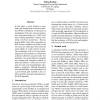281 search results - page 37 / 57 » Similarity-based Word Sense Disambiguation |
79
Voted
EACL
2006
ACL Anthology
15 years 1 months ago
2006
ACL Anthology
In this paper a novel solution to automatic and unsupervised word sense induction (WSI) is introduced. It represents an instantiation of the `one sense per collocation' obser...
94
Voted
ACL
2004
15 years 1 months ago
2004
We describe two probabilistic models for unsupervised word-sense disambiguation using parallel corpora. The first model, which we call the Sense model, builds on the work of Diab ...
71
Voted
EMNLP
2010
14 years 10 months ago
2010
Polysemy is a major characteristic of natural languages. Like words, syntactic forms can have several meanings. Understanding the correct meaning of a syntactic form is of great i...
116
Voted
COLING
2008
15 years 1 months ago
2008
In this paper, an extension of a dimensionality reduction algorithm called NONNEGATIVE MATRIX FACTORIZATION is presented that combines both `bag of words' data and syntactic ...
75
Voted
COLING
2010
14 years 7 months ago
2010
Previous works tend to compute the similarity between two sentences based on the comparison of their nearest meanings. However, the nearest meanings do not always represent their ...

